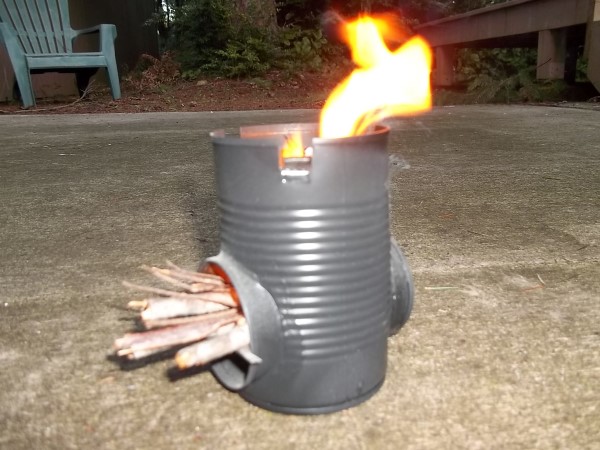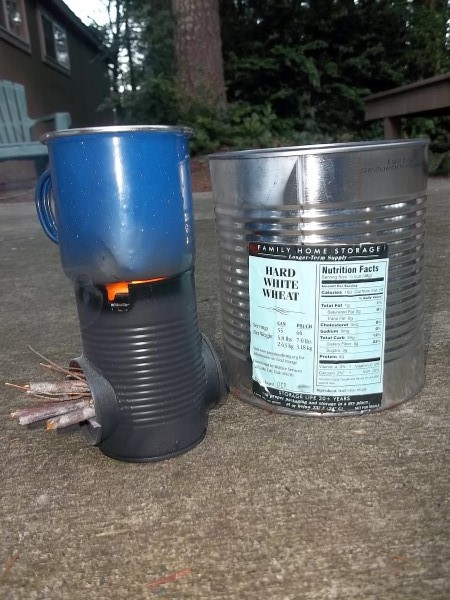I’m sure you’ve seen those #10 rocket stoves by now and maybe you’ve even tried to make one. I’ve done so in the past and they work great! But they are rather bulky and maybe not everyone actually has a #10 can to use or perhaps you simply don’t want something that big.
As such, I decided I would try my had at making what is perhaps the world’s smallest rocket stove.
WARNING: Do realize that you’re going to be cutting metal and WILL have sharp edges so be sure to wear gloves and watch what you’re doing. Safety glasses would also be advisable.
Here’s what I did (see the write-up below the image gallery):
- Remove the labels as best as you can from one vegetable can and two tomato paste cans.
- You’re going to want the cans to end up looking like what’s shown in the photo #2 (more details below). From here on out the middle can will be known as the “first tomato paste can” and the can on the far right will be the “second tomato paste can.” Basically, you’re going to remove the lid of each can using a normal can opener (not a safety can opener), cut holes for a tomato paste can into the sides of the vegetable can (so that a tomato paste can will pass directly through), cut a hole in the middle side of the first tomato paste can for the second tomato paste can to fit, cut down the bottom side of the second tomato paste can, and finally cut a semi-circle into the second tomato paste can too.
- Trace the bottom of a tomato paste can onto a sheet of paper, cut it out with scissors, and use that to mark a proper circle onto whatever you’re wanting to cut out. I found that doubling-over a piece of tape to hold it in place works best.
- Use a fine-tip sharpie marker to mark directly on the cans. You could probably also use a regular sharpie too but a pen or pencil won’t work.
- Use tin snips to cut out the holes. If you have proper metal-working tools this will probably be easy for you but I didn’t. The easiest thing I found to do with what I had was to punch a good sized hole with my knife into the middle of where I wanted to cut out, widen it a bit so my tin snips would fit, and then use my tin snips to slowly work my way toward the line and then around the line like with a pair of scissors. For some reason working in a clockwise motion was easiest. Remember that you WILL end up with sharp edges and projections (at least I did) so be careful here and wear gloves. Filing the sharp edges and projections is a good idea.
- After cutting appropriate holes in the vegetable can and first tomato paste can, cut down the second tomato paste can about 1/2″ from the bottom. You may want to first remove the bottom as you would the top using a can opener to make this cut easier, I did.
- You’ll then want to cut a half circle into the bottom of the second tomato paste can so that it fits as shown here. I actually found that I had to widen the sides of the half circle quite a bit to get it to look as shown in the photo which I needed to do to get the divider to work out later on in step 13.
- To assemble, insert the first tomato paste can into the vegetable can with the hole face up. Now insert the second tomato paste can into the first with the half circle hole facing the opening in the first can. Ensure it’s all centered in the vegetable can. Hopefully that makes sense.
- Cut tabs into the top sides of the vegetable can so that it gives a place for a cup to sit atop. In addition, these tabs hold down the lid you still need to cut and allows a place for the flames to escape. I think I cut three of them down to about 1/2″ or so but your build may vary a bit so just cut it down to about the top of the tomato paste can.
- Cut the vegetable can lid so that a tomato paste can will fit through it. I forgot to take a photo when I did this and so the stove is already painted but the idea is rather simple.
- (optional) I’m still on the fence about this one but since I had some rather large gaps I wanted to make sure no sand escaped and so I caulked the gaps on the outside of the vegetable where the first tomato paste can went through with liquid nails. Thus far it hasn’t melted so I guess it worked out fine. 😉
- (optional) Paint the outside of the stove with high heat black paint. It’s just cooler.
- I also failed to take a photo of the divider that goes into the stove’s side opening. This is a necessary part of the build so that you can place the wood (in this case, twigs) atop the divider while allowing airflow below. Basically, you’re wanting to cut a flatten another can so that you may cut a piece to the width of the center of the tomato paste can (leaving tabs as shown) and to a depth of about halfway into the second tomato paste can. You can see a top-down view in photo 10.
Details of the Cuts:
- The larger vegetable can should have a tomato paste sized hole cut very close to the bottom of the can. My build is about 1/4″ from the bottom but I’d say 1/2″ would have been a better choice. Realize that you’re going to cut holes directly opposite one another so that a single tomato paste can may pass directly through. A single hole won’t work to get the second tomato paste can to center properly.
- The first tomato paste can is the horizontal can and is fairly easy to make. Just cut off the top of the can with a typical can opener and then cut a tomato paste can sized hole in the side of it. I choose to cut it exactly in the middle of the can but after building this I think I could have skewed it about 1/4″ (maybe even 1/2″) towards the UNCUT end of the can. I may try this in the future.
- The second tomato paste can is the vertical can. This one is a bit more difficult but still no big deal. Cut off one end with a can opener like normal. Now, remove about 1/2″ from the OTHER side of the can. You’re also going to need to cut a half circle on this same side of the can. I should have taken a before and after photo as I did have to significantly remove more material from the half circle to get the divider to fit properly. Look at photo #7 to get an idea of how wide it needs to be. Of course, you could shape the divider to fit whatever you wind up with.
Notes and Comments:
- Again, remember to wear proper PPE (gloves and even safety glasses) since you’ll be dealing with sharp metal edges and projections once you start cutting. You can VERY easily cut yourself!
- You may want to file the cuts you’ve made with a metal file (I did in some cases) to reduce later problems with sharp metal when using the stove.
- One problem I had was cutting out the holes on the tomato paste cans. I found that things just didn’t fit right even though I used a template. The problem, I quickly realized, was that the more curvature there was that needed to be cut the more material I needed to remove along the curved sides of the cut. This is hard to explain but I do want you to be aware that things won’t fit quite right even though you followed a template and cut along the lines. It’s not problem, you’ll just need to remove a bit more material.
- Consider making the divider (from step 13) a bit longer to be more stable, though, I didn’t have much trouble with what I did.
- You might also want to drill small air holes into both the divider and top of the vegetable can to allow more airflow. Alternatively, you could just cut more tabs (from step 9).
- If I try this again I might actually try to bend the top of the second tomato paste can so that it funnels the flames even more.
Lastly, add some twigs, a fire starter, and have some fun! In fact, I think I used just one small twig for this photo and got a cup of cold water to boil no problem.

Here’s a reference to a #10 can as comparison with a small cup of water atop the stove:

Overall, this build worked out great. I’d love to hear your thoughts and what you think if/when you try it.












Leave a Reply